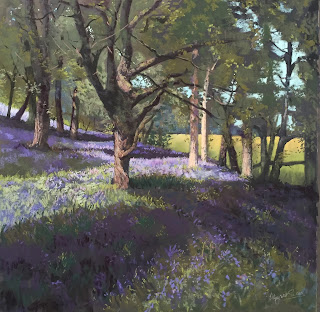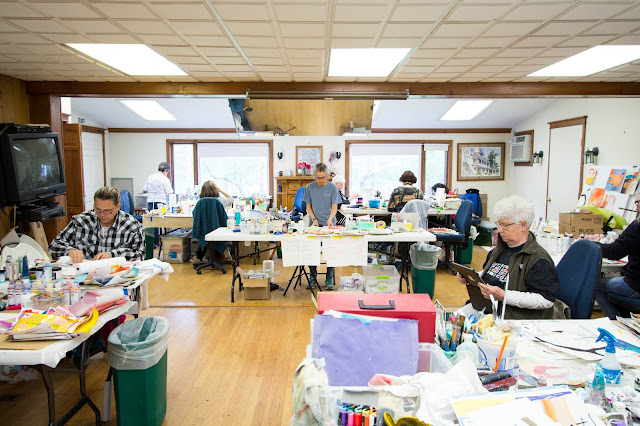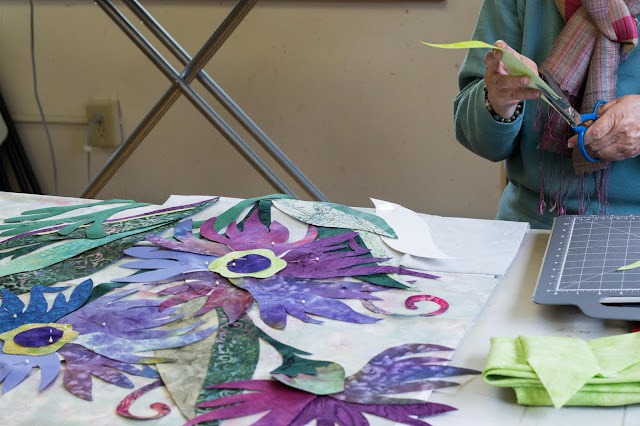We look forward to welcoming quilt artist Paula Nadelstern back to our workshop series next year from April 8-14, 2018! Paula’s workshop will cover unique machine-piecing techniques that are basic and intuitive, as well as both color and fabric guidelines for creating the complex and mobile reflection of a kaleidoscope – specifically for intermediate to advanced students. Get to know a bit more about Paula and her approach to art in our interview with her below!
Q: What’s been your most unexpected source of inspiration?
PN: My own fabric designs inspire me. I’m often asked if I design a specific fabric for a specific new quilt idea. If I understand the question correctly, the answer is no. First come the patterns and then come the quilts. I can’t wait to see where the fabric will lead me; I need to physically handle it to uncover its secrets. I’m as curious as if I hadn’t been part of the process.
I don’t have an art or textile design background. My degrees are in Occupational Therapy with a Masters in Psych, although I haven’t worked in the field in a very long time. Until my unplanned, unexpected apprenticeship with textile designers, everything I knew about color I learned as a kid from my prized box of sixty-four, kid-worthy crayons.
Q: How has teaching impacted your personal art practice? And vice versa, how does your approach to your personal art impact your teaching style?
PN: It’s not until you teach something to someone that you understand it really well. Breaking down your own creative act, first by identifying your personal strategies, and then by dividing them into a sequence of steps, forces you to reflect on what things aren’t as well as what they are. This exploration steers you in lots of valuable directions. It leads you to the vocabulary needed to articulate your private visual language. It helps you recognize the kinds of mistakes students are likely to make and head them off at the pass. And it awakens new ideas, pushing you, the artist, further along your creative path.
A major distinction between the work of a teacher and that of an artist is the proximity to the creative act. The artist initiates and implements the work, investing her entire self into the art. Teaching is also creative but in a very different way. The teacher initiates by sharing an approach but someone else implements. It requires the ability to derive satisfaction from other people’s accomplishments. To be content with being the source of inspiration rather than the one inspired.
Q: What’s one tip you have or trick you use for keeping your studio space organized?
PN: I have no tips for keeping my 12 feet by 15 feet studio organized. Buy a magic wand on Ebay? If you get any good ones, send them my way — if they don’t need a lot of space or take up an inordinate amount of time.
However, here’s how I store my quilts in a two-bedroom, 9th floor New York City apartment. In the living room, I’ve had two 12” wide by 28” high cabinets built. Placed against two walls, the one behind the couch is 92” long and the one under the TV is 72”. There is a door at each end. I roll up the quilts and slip them into the cabinets.
Q: Who are your art heros? Who do you admire and why?
PN: Itchiku Kubota (1917-2003) was a Japanese textile artist. He was most famous for reviving and modernizing a lost late-15th- to early-16th-century textile-dyeing and decorating technique called tsujigahana (literally, flowers at the crossroads). Kubota’s grand scheme was a series of kimonos called Symphony of Light, intended to depict the “grandeur of the universe”. At the time of his death, he had completed 40 of his projected 80 kimono in the series. Kubota’s unique vision for this series involved a decorative landscape design that flowed from kimono to kimono, resulting in a panorama of seasons and views.
I am in awe of his highly refined process creating a fluid, rather than static, surface. Each kimono offers a fresh revelation of the complexities inherent in Kobota’s labor-intensive approach. As he said in his video: he makes you see brown where there is no brown.
Q: What exciting projects are you working on right now or big dream projects you would love to begin exploring?
PN: For the past two summers, I’ve been working on a giant quilt referencing the Old Prague Synagogue Ceiling. As soon as I looked up at this ceiling in 2014, I knew I’d found a quilt idea. I am a Patternista, hardwired to see pattern everywhere and here was a glut of designs bumping into each other. I think I could work on this one quilt for the rest of my career, editing, auditioning and refining as the nuances and possibilities of the concept evolves. It will be the forty-first quilt in my KALEIDOSCOPIC series.
—
Learn more about Paula’s Kaleidoscope Quilts workshop here.
Find out more about Paula on her website.


























































































 1 1/2 cups of cottage cheese (I use Cabot’s whole milk cottage cheese)
1 1/2 cups of cottage cheese (I use Cabot’s whole milk cottage cheese)





